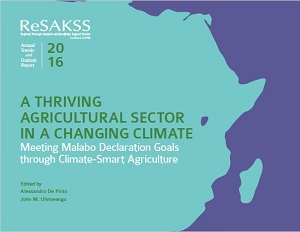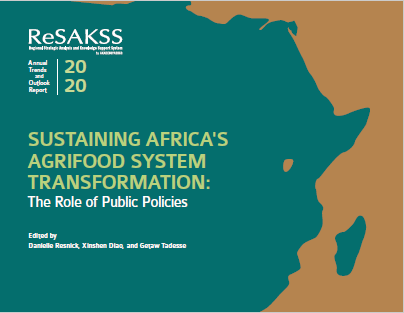BOOSTING GROWTH TO END HUNGER BY 2025: The Role of Social Protection
AUTHOR
Fleur Wouterse and Alemayehu Seyoum Taffesse
SERIES NAME
ReSAKSS Annual Trends and Outlook Report
YEAR
2018
ABSTRACT
Social protection initiatives in Africa increasingly aim to institutionalize systems that guarantee assistance for the poor and protect the vulnerable against livelihood risks. Through direct and indirect income effects, social protection programs can also play an instrumental role in promoting agricultural development and, more broadly, economic growth.
Two major trends will determine the future demand for social protection in African countries. One is the persistent high rates of poverty that are the result of decades of economic decline and stagnation that preceded the recent economic recovery. The other is the transition toward more democratic, pluralistic political systems combined with faster economic growth and a more vocal urban segment of the poor and vulnerable population. This combination is bound to lead to growing demand for social protection and increasing pressure on governments to respond or face certain social upheaval.
The 2017-2018 Annual Trends and Outlook Report (ATOR) takes an in-depth look at social protection in rural Africa to address these three questions, which are particularly relevant as Africa embarks on the implementation of the Malabo Declaration commitments and the African Union’s Agenda 2063. First, the contributed chapters summarize and synthesize the available evidence on successful implementation of social protection programs in rural Africa. Second, the report fills in knowledge gaps on how to maximize the role of social protection in reducing vulnerability and increasing resilience of rural households. Third, the report highlights policy implications to guide the design and roll-out of national social protection programs for rural Africa.
Executive Summary
Chapter 1 Introduction
Chapter 2 Synergies between social protection and agriculture
Chapter 3 Agriculture and social protection: The experience of Ethiopia’s productive safety net program
Chapter 4 The impact of social grants on agricultural entrepreneurship among rural households in Kwazulu-Natal, South Africa
Chapter 5 The impact of cash transfer programs in building resilience: Insight from African countries
Chapter 6 The impact of humanitarian food assistance on household food security during conflict in Mali
Chapter 7 The role of social protection in improving child wellbeing and care in Africa
Chapter 8 Livelihood, cash transfer, and graduation approaches: How do they compare in terms of cost, impact, and targeting?
Chapter 9 Heterogeneity in target populations and locations: Reflections on the challenges for poverty targeting
Chapter 10 Targeting social safety nets using proxy means tests: Evidence from Egypt’s Takaful and Karama program
Chapter 11 Designing social protection programs
Chapter 12 Tracking key CAADP indicators and implementation processes
Chapter 13 Conclusion
PUBLISHER
International Food Policy Research Institute (IFPRI), Washington DC, USA


